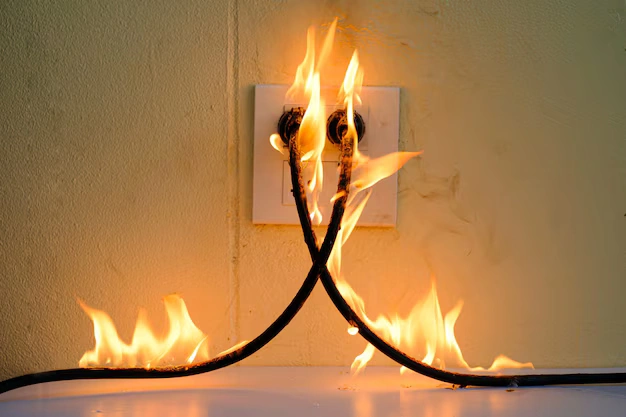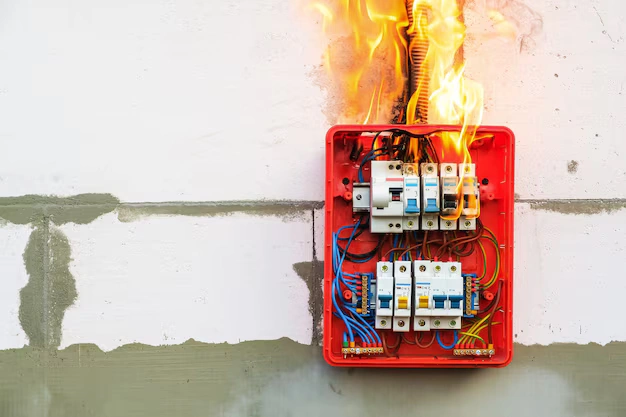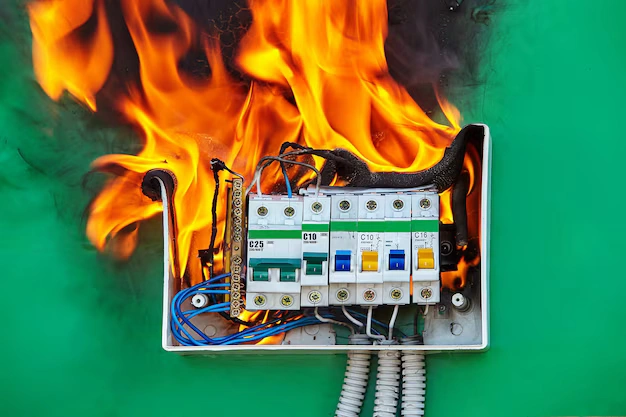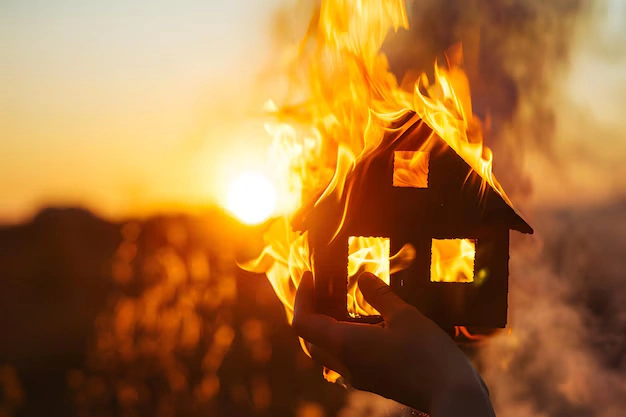Home renovations bring some risks but can also be an excellent way to add value to your living area. One of the biggest threats is electrical fires. According to the National Fire Protection Association (NFPA), there are over 40,000 home fires in the United States every year due to electrical malfunctions. These fires cause hundreds of deaths, thousands of injuries, and millions of dollars in property damage. Most of these electrical fires occur during home remodeling work, usually as a result of improper installation or outdated wiring. This article also highlights the most common electrical fire risks during renovations as well as how to avoid them and keep your home safe.
Overloaded Circuits
In the course of a home renovation, a lot of people make it a point to add new appliances, lights, or outlets. While this may seem like a great plan to accommodate new needs, without the proper checks, it can quickly overload your existing Electrical Fire. An overloaded circuitry exists when several devices are connected to the same circuitry, which makes it overheat. This causes melted wires, sparks, or even an electrical fire.

Many older electrical panels also aren’t set up for the extra load that comes with new appliances or more outlets. Whether you have an older system or a new one, excessive loading on one circuit can create a fire hazard. Overloaded circuits are especially hazardous because they can result in short-circuiting or electrical arcing, which can ignite a fire.
How to Avoid It:
- Collaborate with an electrician to confirm that your electrical panel and circuits are equipped for the increased electrical load of new appliances or outlets.
- Dedicated circuits may be necessary for high-power appliances like refrigerators, microwaves, or air conditioning units to avoid tripping the circuit.
- If you need to add more circuits or a higher capacity, consider upgrading your electrical panel and if you’re adding many new Electrical Fire, you’ll likely need to.
Using Faulty or Cheap Materials
During a renovation, it may be tempting to try to save on costs by getting inexpensive electrical materials, for example, wires, outlets, switches, or circuit breakers. That said, it28519fce33a6a12d6020d490169bb28e is fading or faulty electra28384u material29140a, where there is a much greater risk of electrical28401cde44ab1ab305f5005b5b12170f2660f deception284f0g07 in fian75203670h37 35k29041ff3caaf334c5e28baadf1ehgre. Low-cost or shoddy components are more prone to failing, overheating, or creating electrical shorts.
Under normal use, poor-quality wires or components can heat up rapidly, and there is enough heat to ignite a fire. Cheap materials may not conform to safety standards and can fail, endangering your home.
How to Avoid It:
- When working with any electrical work, always use code-approved electrical materials. Inexpensive or faulty wiring is a fire hazard and should never be part of a home renovation.
- Ensure you, your home, and your family are safe by purchasing electrical supplies from reputable brand names or suppliers that stand behind their products.
- All Electrical Fire components (outlets, switches, wiring, etc.) should be UL (Underwriters Laboratories) or meet other safety testing guidelines.
Exposed Wires and Cables
Open wires pose a major fire risk. Electrical wires are often damaged or subjected to dust or moisture during renovations. Exposed wires can spark, short out, or overheat, and a fire will grow quickly from there. Wiring may also be exposed when walls or ceilings are opened up for renovations, leaving electrical systems prone to damage.
Exposed wires also might be more susceptible to touching other substances that could serve as a pathway for electricity to travel, potentially causing it to spark up or short out. The risk is particularly high in construction work areas during renovations where moisture levels are high, such as bathrooms or kitchens.
How to Avoid It:
- Be sure that all necessary wires are insulated or coated in a way that prevents both contact with other objects and damage to the wires themselves.
- Conceal permanent electrical wiring behind walls, ceilings, and floors where practical. That reduces the chance of accidental damage.
- If cables are visible after a remodel, for example, be sure they are anchored and insulated to avoid being brushed by a passing thigh or elbow.
Improperly Installed Electrical Boxes and Outlets
If you’ve ever installed an electrical box outlet, you know it is essential for safely storing electrical connections. When they are improperly installed, they can result in overheating, electrical arcing, or malfunctions that can ignite fires. Electrical boxes may overheat, or outlets may short out, if they are not properly mounted or if the outlets are not properly connected.

Moreover, placing outlets on the wall in places likely to be splashed with water—for example, near sinks or bathtubs—poses an electrocution and fire risk. Faulty or improper installation of electrical boxes or outlets may not be immediately visible, but they can pose high fire risks if they are not corrected.
How to Avoid It:
- Check that electrical boxes are securely installed and properly sized for the wiring.
- Place outlets at least 3 feet from water sources and install ground fault circuit interrupters (GFCIs) in moisture-prone areas such as bathrooms, kitchens, and outdoor spaces.
- Have an electrician ensure that all electrical boxes and outlets are installed, grounded, and in safe locations.
Not Following Electrical Codes
To safeguard all electrical installations, electrical codes are implemented. Neglecting to comply with local electrical codes during a renovation can result in improper installations that are at high risk of electrical hazards, including fires. So, it is important to follow electrical codes that have been updated regularly to meet new safety technologies.
Ignoring these codes may result in you having bad installations, overloaded circuits, poor and frustrating wiring that does not meet safety standards, and subject your home to dangerous conditions.
How to Avoid It:
- Partner with a licensed electrician who knows the current codes and regulations on electrical work.
- Just obtain any permits you need for electrical work. As work is completed, inspections are often required to confirm that what was done meets safety standards.
- Verify that all electrical work performed during your renovation conforms to local building codes, particularly if you are adding or modifying circuits.
Neglecting to Test Electrical Systems
During the revamping, the electrical system must be tested to let you know everything works fine once the revamping is over. Untested or poorly tested systems can conceal problems that might not surface immediately. Issues like dim wiring, bad sockets, or overworked circuits may be hidden from sight, but those can generate a blaze if not spotted.

Testing will help identify and rectify any hazards before they result in fire.
How to Avoid It:
- After you finish all electrical work, have a licensed electrician check it. [Emphasis added] This means examining circuits, outlets, lights, and appliances to make sure everything operates safely.
- Tools can include circuit testers or electrical meters used to test for wiring and to ensure that connections are safe and functional.
- Just because the system works doesn’t mean everything is okay. As always, do a thorough inspection for safety.
Conclusion
The risk of electrical fire during renovations is higher, but they can be avoided with careful planning and precautions. You can help lower the risk of fire by ensuring common problems such as incorrect wiring, overloaded circuits, and faulty materials are not found in your home. Always ensure you work with qualified professionals, follow electrical codes, and test your system thoroughly to keep your home safe. If this is in place, you can undertake a safer renovation and enjoy a safer home.
Frequently Asked Questions (FAQs)
What is the purpose of this article?
The most common risks include improper wiring, circuitry overload, subpar materials, and exposed wires.
Can I do my own electrical work if I’m renovating?
Electrical work is best done by a licensed electrician. Overzealous home improvement efforts can create a lot of opportunities for mistakes and hazardous situations in the realm of electrical work.
How will I know if I have too many circuits?
Overloaded circuits may trip breakers, cause hot outlets, or flicker lights. If you observe any of them, call an electrician.
What are the consequences of not following electrical codes during renovations?
Yes, following electrical codes is very important for safety. When a job is done up to code under the electrical code guidelines, that means it’s up to current standards.
How often should I test my electrical system after renovations?
Once electrical work has been performed, test your system. Also, regularly test to ensure all is working safely.


